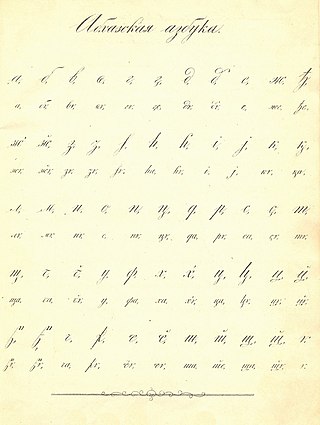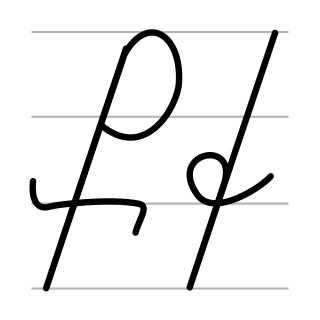
D, or d, is the fourth letter of the Latin alphabet, used in the modern English alphabet, the alphabets of other western European languages and others worldwide. Its name in English is dee, plural dees.

G, or g, is the seventh letter of the Latin alphabet, used in the modern English alphabet, the alphabets of other western European languages, and others worldwide. Its name in English is gee, plural gees.

The Latin alphabet, also known as the Roman alphabet, is the collection of letters originally used by the ancient Romans to write the Latin language. Largely unaltered excepting several letters splitting—i.e. ⟨J⟩ from ⟨I⟩, and ⟨U⟩ from ⟨V⟩—additions such as ⟨W⟩, and extensions such as letters with diacritics, it forms the Latin script that is used to write most languages of modern Europe, Africa, America and Oceania. Its basic modern inventory is standardised as the ISO basic Latin alphabet.

M, or m, is the thirteenth letter of the Latin alphabet, used in the modern English alphabet, the alphabets of several western European languages and others worldwide. Its name in English is em, plural ems.

P, or p, is the sixteenth letter of the Latin alphabet, used in the modern English alphabet, the alphabets of other western European languages and others worldwide. Its name in English is pee, plural pees.

The Abkhaz alphabet is a Cyrillic alphabet used for the Abkhaz language.

Pharyngealization is a secondary articulation of consonants or vowels by which the pharynx or epiglottis is constricted during the articulation of the sound.
In phonetics, ejective consonants are usually voiceless consonants that are pronounced with a glottalic egressive airstream. In the phonology of a particular language, ejectives may contrast with aspirated, voiced and tenuis consonants. Some languages have glottalized sonorants with creaky voice that pattern with ejectives phonologically, and other languages have ejectives that pattern with implosives, which has led to phonologists positing a phonological class of glottalic consonants, which includes ejectives.
Pe is the seventeenth letter of the Semitic abjads, including Arabic fāʾف, Aramaic pē 𐡐, Hebrew pēפ, Phoenician pē 𐤐, and Syriac pē ܦ..

Pe is a letter of the Cyrillic script.

W with acute is a letter of the Latin alphabet formed by addition of the acute diacritic over the letter W. In the past, it was used in Lower Sorbian and Middle Polish. Now it is used in the Welsh orthography as an accented form of w, e. g. gẃraidd 'manly'.

Ḷ is a letter of the Latin alphabet, derived from L with a diacritical dot below. It is or was used in some languages to represent various sounds.
Unicode supports several phonetic scripts and notation systems through its existing scripts and the addition of extra blocks with phonetic characters. These phonetic characters are derived from an existing script, usually Latin, Greek or Cyrillic. Apart from the International Phonetic Alphabet (IPA), extensions to the IPA and obsolete and nonstandard IPA symbols, these blocks also contain characters from the Uralic Phonetic Alphabet and the Americanist Phonetic Alphabet.

Pe with middle hook is a letter of the Cyrillic script. Its form is derived from the Cyrillic letter Pe (П п) by the addition of a hook to the middle of the right leg.

The letter Ƥ, called P with hook, is a letter of the Latin alphabet based on the letter p. It is used in some alphabets of African languages such as Serer.

The C with bar, also known as barred C, is a modified letter of the Latin alphabet, formed from C with the addition of a bar. It was used in the final version of the Unified Northern Alphabet, approved in 1932, for Saami, Selkup, Khanty, Evenki, Even, Nanai, Udege, Chukchi, Koryak and Nivkh languages to denote the sound, although in some of these languages in practice, several other alphabets were used. Also, this letter was used in the Latinized Shugnan alphabet (1931-1939) to denote the sound.
B with acute is a letter of the Latin alphabet formed by addition of the acute accent over the letter B. It is used in Ntcham and Shinasha, and Võro. It also used to be used in Upper Sorbian, Lower Sorbian and Polish.

Pe is the twenty-sixth letter of the Armenian alphabet. It has a numerical value of 800. It is created by Mesrop Mashtots in the 5th century. In Eastern Armenian, it represents the voiceless bilabial stop (/p/) while in Western Armenian, it represents the voiced bilabial stop (/b/).

Ben is a letter of the Armenian alphabet, used in the Armenian language.

Keh, or Kʼe is the thirty-sixth letter of the Armenian alphabet. It represents the voiceless aspirated velar plosive (/kʰ/) in both Eastern and Western varieties of Armenian. Created by Mesrop Mashtots in the 5th century, it has a numerical value of 9000. Its shape in lowercase form resembles to the Latin letter P (p), but stroked.
















